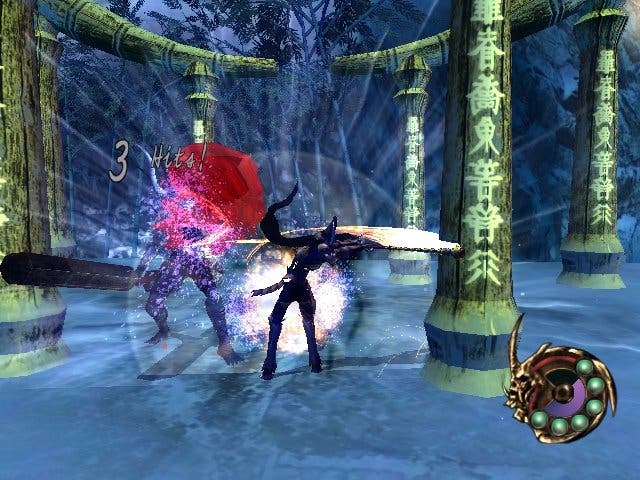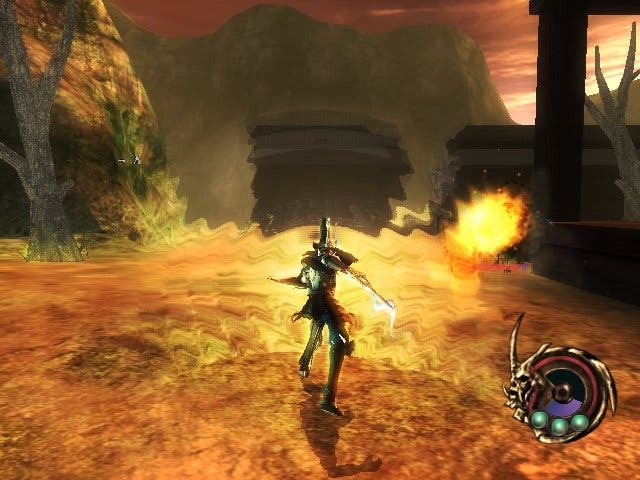Otogi - Myth of Demons
Kristan takes a slash with Sega's latest sword wielding Xbox exclusive.
Hack and slash. Hackandslash. On several occasions this year we've been pressed into action to wave a mighty sword at an Army of Evil, jump like a flea on a hotplate and dispense the kind of magic that would have had dear old Freddie Mercury howling like Montserrat Caballe.
Most notably Capcom's PS2 drinking buddies Devil May Cry 2 and Chaos Legion had us slicing and dicing various nefarious types earlier this year, and From Software's Otogi continues in a largely similar vein - albeit exclusively on the Xbox and with supremely impressive visuals that lay the smack down on either effort.
Perpetual darkness. A bit like Tom's living room.

As with all RSI inspiring button mashers, Otogi is a maximum action/minimum storyline opus with alleged RPG elements that'll push your aching digits to the limit across 29 evil strewn levels. Typically, there's a thoroughly superfluous storyline to try and justify proceedings; some kind of seal has been (clubbed?) broken leaving the land in perpetual darkness for over 1,000 years and a haven for evil types (of which there are over 40) to stand around waiting for an undead warrior to come along and send them back to hell, presumably.
Just as well that Raikoh, the aforementioned undead warrior, is a bit handy with a bloody great sword, and despite his recent falling out with David Blaine is pretty sorted for magic tricks too - always useful when it's your job to slay an Army of Evil intent on snuffing out life itself.
As an audio/visual experience, you'll be seduced immediately. It's yet another fantastic example of Sega's ability to sign games that really show off the capabilities of the Xbox. After the astonishing visual feast that was Panzer Dragoon Orta, Otogi yet again gives Xbox owners the bragging rights over the competition. On a decent widescreen TV, From's latest delights with some truly exceptional artistry that makes the most of the fantasy setting of ancient Japan. The backdrop to each level is never less than stunning, with great use of lighting, exquisitely detailed buildings, with a marauding horde of evil that leaps straight out of the pages of fractured graphic novel minds, and some excellent animation bringing these troubled beings to life superbly.
Simple

Complementing all this visual mastery is a superb soundtrack that twangs away in the background in full surround sound, adding delicious depth to an already compelling visual experience. Just a shame, then, that the English translation and voiceovers don't quite make the translation, although are certainly a cut above those normally associated with Japanese sofcos.
Throughout the game, and whichever of the 33 weapons you're in possession of, the controls remain utterly simple. Hit B for a light attack, Y for a heavy attack, A for jump/double jump, left trigger for dash, right for lock-on, and X to cast a spell (hold for a greater charge). A few combos spice things up a tad, such as the Boost or Dash attacks, while hitting B or Y at the right time can deflect enemy spells.
But all this frantic combat isn't confined to the enemy, as From offers a bonus for destroying every inanimate object in each stage, with human spirits (cough) confined in every one of them. Tenuous yes, but it means it can show off how impressively destructible each level is.
Meanwhile the same principle applies to the enemies contained within each stage, with Gold awarded to you for each demon you slay, and the more currency you accumulate, the better weapons/magic/items you can buy and so on. In a nod to various Capcom titles, each slain enemy expels a collection of coloured blobs (purple, green, red, blue) which augment your experience ratings (HP, Magic, Attack, Defend) RPG-style and eventually turn you into an even harder bastard.
Random tat alert

Taken to its bare bones, there's usually one key objective per level (destroy the boss, smash the lamps, etc), and it is possible to almost completely ignore everything else if you want to just whizz through the game quickly. In fact, some levels will reward you with special items/weapons should you complete them within a time limit, so you'll doubtlessly have to replay each level multiple times to unearth all the random tat that's stored within.
But one thing that stands in your way of clearing each level is the fact that you die if your continually draining magic ticks down to nought. Killing enemies and the occasional recharge vial tops it up, but it still forces you to strike a balance between getting on with the task in hand and collecting more gold/experience, adding a layer of tension to what would otherwise be a fairly straightforward game.
The combat itself is a curious experience thanks to Raikoh's ability to basically jump into thin air (magic permitting). Holding down the left trigger and performing a light or heavy attack on an enemy has the effect of swiping upwards into the sky. Effective, but an odd experience that never really feels particularly convincing, especially as some heinous camera work makes it largely guesswork as to whether your slashes will make contact. Why the combat couldn't have taken place on the ground, we're not sure, because all this aerial ballet just confuses matters.
Meanwhile, despite the main objectives changing slightly between missions, it quickly becomes an utterly repetitive experience, and even more so thanks to the fact that the game recycles the levels after the halfway point, albeit with slightly different graphics. Once you've got a feel for the game and upgraded Raikoh sufficiently, most levels can be licked in a matter of minutes on perhaps your third attempt, with the difficulty level remaining fairly consistent throughout. Add to that the lack of incentive to explore, and no puzzle elements to keep things varied you're unlikely to get much more than 12 hours entertainment out of Otogi unless you're obsessed with clearing every level perfectly.
Bored
The net result is that Otogi's underlying simplicity bored us pretty quickly. Of course, there's a ton to collect, a decent number of levels and the package is dripping with audio/visual quality to keep you interested, but it wasn't enough. This button mashing hackandslash lark needs an injection of new ideas - RPG pretensions don't hide the core fact that Otogi feels a pretty vacuous beast: gorgeous or not.

